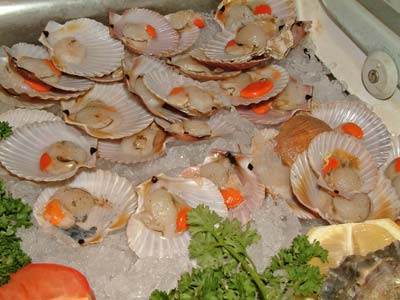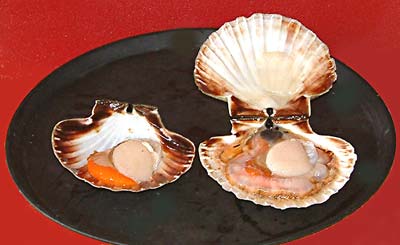Rather heavy gnocchi from Trentino-Alto Adige, similar to small dumplings. Among the tastiest are those with calf’s liver served in thick broth. They may be made with breadcrumbs from white or rye bread, flavoured with speck (smoked ham) and sausage.
"Big basket." Any cheese moulded in a wicker or reed basket might be called Canestrato. There is a hard Sicilian version made from sheep's milk which is also known as Pecorino Siciliano.
"Big Basket from Puglia." A hard sheep’s milk cheese from Foggia. It is moulded in a reed basket. (PDO).
"Little baskets." Ring-shaped sweet biscuits (US: cookies) made with almonds and flavoured with orange flower water, served at breakfast in Liguria. For festivals and feasts they are decorated with tiny, sweet, coloured confetti.

"Little basket." Pilgrim or great scallop. These are shellfish with white meats and pink corals, often cooked in their shells with the corals and have sweet, succulent meat if properly cooked. According to legend, the body of St James (St-Jacques) travelled with a boat with neither oars nor sails around the Iberian coast, coming to rest in Compostela. Many miracles were associated with this journey, including one where the horse of a pagan nobleman leaped into the sea. They emerged carrying the body of St James covered in scallop shells. This resulted in the nobleman converting to Christianity. Pilgrims to Santiago de Compostela have traditionally worn scallop shell badges in commemoration of St James, or used scallop shells as begging bowls. The whole pilgrim route is decorated with his emblem. In some parts of Europe they are eaten on the feast day of St James on 25 July to commemorate the arrival of pilgrims or peregrinos at Santiago de Compostela, often with tomatoes and garlic. They are more often simply and lightly fried.
"Little baskets." Small pasta shapes made from small circles with ruffled edges brought together and pinched in the middle. Even smaller ones are called panierini. Canestrino is also a name for a pilgrim scallop.

"Little baskets." Pilgrim or great scallops. These are shellfish with white meats and pink corals, often cooked in their shells with the corals and have sweet, succulent meat if properly cooked. According to legend, the body of St James (St-Jacques) travelled with a boat with neither oars nor sails around the Iberian coast, coming to rest in Compostela. Many miracles were associated with this journey, including one where the horse of a pagan nobleman leaped into the sea. They emerged carrying the body of St James covered in scallop shells. This resulted in the nobleman converting to Christianity. Pilgrims to Santiago de Compostela have traditionally worn scallop shell badges in commemoration of St James, or used scallop shells as begging bowls. The whole pilgrim route is decorated with his emblem. In some parts of Europe they are eaten on the feast day of St James on 25 July to commemorate the arrival of pilgrims or peregrinos at Santiago de Compostela, often with tomatoes and garlic. They are more often simply and lightly fried.